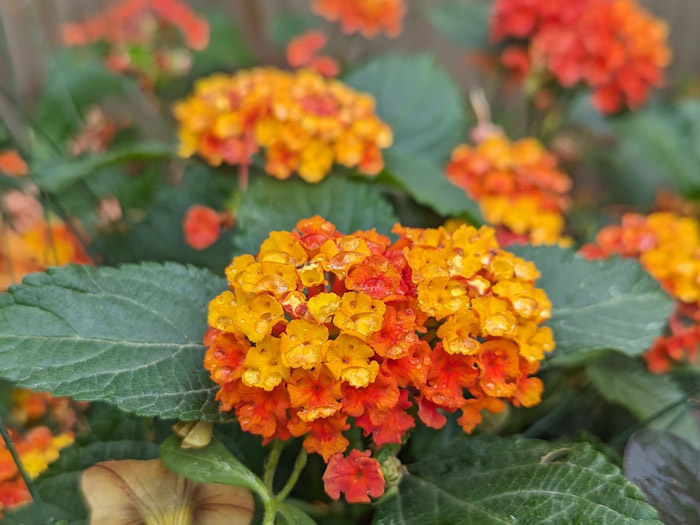Lantana is a plant that I find has a very specific demographic. To those who actually know about it, it is the most wonderful, colourful, and unique plant. To those who breeze past it, it’s nothing. Lantana is a slow grower and so usually in the heat of greenhouse shopping it just looks like a little green leafy plant, unless you know what you’re looking for you most likely won’t notice it. But this little annual packs quite the punch when it comes to colour and versatility. Lantanas grow round heads full of tiny flowers. These flowers can come in many shades from whites, pastels, and soft yellows to fiery red, hot pinks, and oranges. What’s even more fun is that so many of the Lantana varieties come in an ombre of colour, transitioning along the flower head from one colour to the next. It’s truly an incredible feat of nature. There are very few if any other flowers we carry that do that. Lantana can be drought tolerant, love lots of hot sun and are prolific bloomers. Another interesting thing I didn’t know about Lantana is that some varieties produce berries! Now I will say I have never seen such conflicting reports on the edibility of a berry but when I say that there is discourse on the conclusion, I mean there’s discourse! One article says that berries are edible, the next said they were lethal, so here’s my opinion. JUST DON’T EAT THEM! Ahem… sorry I didn’t mean to shout, but I need to be clear, if we don’t know if they are edible or LETHAL, please don’t eat them!
Though Lantana is an annual it can be cared for as a houseplant, even being trimmed, and trained into a small tree. Although this takes time and a lot of patience it is a very doable task! However, as incredible as the lantana is here for us in colder climates, it is notorious around the world, and not in a good way. Lantana in hotter climates are a perennial or even a year-round shrub. As much as I dream of having a lantana shrub, they are actually incredibly invasive! Back in the 1800’s explorers brought Lantana from central America back to Australia to be used as a bedding plant. People were thrilled with the gorgeous flowers and the SIX-FOOT-TALL shrub that it was growing into. Six feet tall! What a dream… or so they thought. In the mid 1900’s the plant was suddenly declared a noxious weed. Due to it thriving in the climate and the birds devouring their berries the plant began to spread aggressively. To this day Lantana is considered an invasive species. Unfortunately, Australia wasn’t the only warm climate country to fall for the lovely Lantanas trap. In countries across the world this plant has been declared noxious, invasive, and dangerous to their ecosystems. This is the only time I am thankful for our cold winters because, just like our black-eyed Susan vine, given the right temperature Lantana would take over our world! I was really hoping to find more information on Lantana’s history, but all these articles have been buried under countless articles about the invasiveness of Lantana and government PSA’s about their plan of action against the invader. I tried to weed through all of these articles but after a long time I just decided to leave it there. Who knew that this lovely little plant that we’ve been fascinated with was secretly taking over the world.




